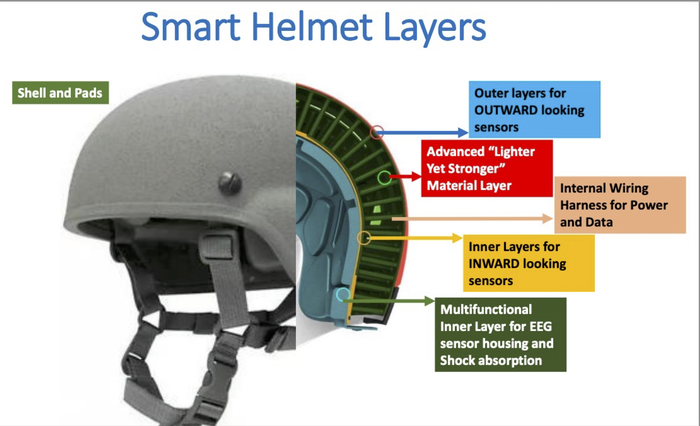HOUSTON – (Nov. 10, 2021) – Rice University researchers have received $1.3 million from the Office of Naval Research through the Defense Research University Instrumentation Program to create the world’s first printable military “smart helmet” using industrial-grade 3D printers.

Credit: Rice University
HOUSTON – (Nov. 10, 2021) – Rice University researchers have received $1.3 million from the Office of Naval Research through the Defense Research University Instrumentation Program to create the world’s first printable military “smart helmet” using industrial-grade 3D printers.
Led by principal investigator Paul Cherukuri, executive director of Rice’s Institute of Biosciences and Bioengineering, the Smart Helmet program aims to modernize standard-issue military helmets by 3D-printing a nanomaterial-enhanced exoskeleton with embedded sensors to actively protect the brain against kinetic or directed-energy effects.
Rice will utilize Carbon Inc.’s L1 printer to develop a strong-but-light military-grade helmet that incorporates advances in materials, image processing, artificial intelligence, haptic feedback and energy storage. The printer enables rapid prototyping that in turn simplifies the process of incorporating the sensors, cameras, batteries and wiring harnesses the program requires, Cherukuri said.
“Current helmets have evolved little since the last century and are still heavy, bulky, passive devices,” he said. “Because of advances in sensors and additive manufacturing, we’re now reimagining the helmet as a 3D-printed, AI-enabled, ‘always-on’ wearable that detects threats near or far and is capable of launching countermeasures to protect soldiers, sailors, airmen and Marines. Essentially, we’re building J.A.R.V.I.S.”
The Smart Helmet program will use technology drawn from projects like the FlatCam, a system developed by co-investigator and electrical and computer engineer Ashok Veeraraghavan and his colleagues that incorporates sophisticated image processing to eliminate the need for bulky lenses, as well as Cherukuri’s Teslaphoresis, a kind of tractor beam for nanomaterials that could help create physical and electromagnetic shields inside the helmets.
“A smart helmet task force has been assembled from some of the finest minds at Rice to tackle the challenge of creating a self-contained, intelligent system that protects the warfighter at all times,” Cherukuri said. The task force includes the labs of materials scientist Pulickel Ajayan, civil and environmental engineer and Rice Provost Reginald DesRoches, mechanical engineer Marcia O’Malley, chemist James Tour and Veeraraghavan.
While the location of the L1 has yet to be determined, a Carbon M2 printer will be located at the Oshman Engineering Design Kitchen (OEDK), where it will be available for projects other than the helmet. Rice undergraduates who design and build their mandated capstone projects at the OEDK are taking part in the helmet project, working alongside graduate students and postdoctoral researchers to develop the heads-up display.
“We’ve got a lot of innovative tech in university labs that has never seen the light of day,” Cherukuri said. “We’re simply developing that technology into a device that gives the men and women protecting our country a real chance at coming home safe and sound. This is for them.”
-30-
This news release can be found online at https://news.rice.edu/news/2021/rice-tapped-develop-3d-printed-smart-helmets-military.
Follow Rice News and Media Relations via Twitter @RiceUNews.
Related materials:
Institute of Biosciences and Bioengineering: https://ibb.rice.edu
Oshman Engineering Design Kitchen: http://oedk.rice.edu
Wiess School of Natural Sciences: https://naturalsciences.rice.edu
George R. Brown School of Engineering: https://engineering.rice.edu
Images for download:
https://news-network.rice.edu/news/files/2021/11/1115_HELMET-1-WEB.jpg
The Rice University-designed smart helmet is intended to modernize standard-issue military helmets by 3D-printing a nanomaterial-enhanced exoskeleton with embedded sensors to actively protect the brain against kinetic or directed-energy effects. (Credit: Rice University)
https://news-network.rice.edu/news/files/2021/11/1115_HELMET-4-WEB.jpg
CAPTION: Paul Cherukuri. (Credit: Rice University)
Located on a 300-acre forested campus in Houston, Rice University is consistently ranked among the nation’s top 20 universities by U.S. News & World Report. Rice has highly respected schools of Architecture, Business, Continuing Studies, Engineering, Humanities, Music, Natural Sciences and Social Sciences and is home to the Baker Institute for Public Policy. With 4,052 undergraduates and 3,484 graduate students, Rice’s undergraduate student-to-faculty ratio is just under 6-to-1. Its residential college system builds close-knit communities and lifelong friendships, just one reason why Rice is ranked No. 1 for lots of race/class interaction and No. 1 for quality of life by the Princeton Review. Rice is also rated as a best value among private universities by Kiplinger’s Personal Finance.




